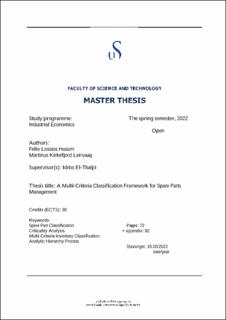| dc.description.abstract | The offshore petroleum industry can be described as a capital-intensive industry. Capital intensive refers to a heavy and high-value asset structure with long lifetimes that demands considerable effort to maintain. Large investments are required to produce goods and services, and the consequences of downtime, shortage and production loss are extensive. Efficient and reliable maintenance operations are essential to secure safe, productive and reliable production, creating a great incentive to stock up on all kinds of spare parts to reduce the consequences of the above-mentioned. However, there are great costs and inefficiencies related to spare parts inventories. Holding costs are high, turnover ratios are low, and inconsistent demand patterns make demand difficult to predict. Therefore, the trade-off between availability and efficiency is a fundamental principle in inventory management of spare parts.
The industry puts a lot of effort into optimising spare parts inventories and spends resources on developing efficient and reliable spare parts operations. Among these efforts is spare parts classification. This is the process of classifying spare parts into distinct groups and is crucial to control the enormous number of parts with different characteristics. The decisions on which characteristics to use in classification practices is not straightforward and has been subject to research and debate for many decades.
In current classification practices, most spare parts of an equipment are assigned the same criticality rank as the equipment itself, which is not necessarily the case. Therefore, Moreld Apply AS are interested in developing a method for spare parts classification that further evaluates criticality and consequence analysis on a spare parts level. This study presents a way to classify spare parts using a multi-criteria framework to establish precise criticality classes for each part.
The findings in this thesis have ultimately led to the conclusion that multi-criteria approaches have great potential in the classification practices in the industry. We also see that the framework is already implementable for single case scenarios, such as the one analysed in this thesis, and provide reliable results. The results indicate that, in almost all instances, the criticality level of spares is reduced compared to the main equipment.
The main contributions of this thesis is a framework with several steps guiding the user through the process of setting up the evaluation, preparing the analysis, as well as doing the analysis. Important aspects will be the selection of the most appropriate classification criteria, data collection processes and preparation activities. These topics form the main body of research. | |
